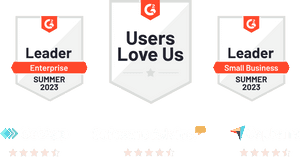
SMART Goals planning method
For decades, managers have used the SMART Goals system to cut through the haze of corporate strategy. This planning method became incredibly popular and spun off many variants; it brought clarity and specificity to the often-vague and esoteric executive planning sector. This simple little scheme brings big dreams down to earth and helps leaders develop sharp tactics to match their grand strategies.
What are SMART Goals?
Leaders and groups typically use the SMART Goal system to make decisions and make concrete plans from larger visions. They follow this scheme when it's time to get practical and delineate expectations between groups, leaders, and teams.
What does SMART stand for?
In short, the SMART acronym helps you remember the five aspects of comprehensive, actionable goal-setting. I'll go into greater detail further down the page; for now, check out this simple SMART Goals definition:
- Specific -- Divide long-term strategies up into actionable, short-term tactics, so everyone in your organization knows where they stand.
- Measurable -- Frame tasks so you can quantify them for accountability and analysis.
- Attainable -- Hit that sweet spot between asking too little and too much from your team members.
- Relevant -- All projects (and steps within projects) must align with your corporate mission to increase stakeholder buy-in and dedication.
- Time-Bound -- Avoid mission creep and motivate employees with appropriate time goals for all projects.
Some business experts add the terms Evaluated and Reviewed to the SMART Goals system (to create the acronym SMARTER). They emphasize the need for constant analysis and optimization in project cycles.
SMART Goals Template
Fill out each of the sections on your printable SMART Goals template while reading the content below.

All these steps have one thing in common: boundaries. Whether you’re setting specific daily production goals or putting time constraints on your monthly design budget, SMART goals mean knowing your limits.
Have your employees work up to their capacity but not far beyond. Challenge people to grow, but not at an overwhelming pace. Make each workday another step in an ongoing process, not a heroic and unsustainable effort.
SMART Goals - Detailed Steps
S -- Specific
Also called Simple, Significant, and Sensible, this SMART Goal step exemplifies the entire system. By setting clear and concrete goals, you can create stability, accountability, and trust in your workplace.
By keeping it simple, you prevent information overload and overly-long strategy meetings. Used properly, SMART Goal sessions can be quick, efficient, and concrete.
Consider this decision-making system more like sharpening your pencil before getting to work than debating the right color of pencil leads in a 5-hour meeting. Remember, the time you and your team spend in meetings cuts directly into productive work time.
Significance matters in all steps of the SMART Goal technique. People need to know their efforts make a difference for the company -- and beyond. Deep, intrinsic motivation comes from buy-in. You can pay people to show up and work according to your expectations; however, you'll only get the most from your people if they feel valuable to your organization and genuinely connected to its mission.
If you're a dream big, pie-in-the-sky leader, remember to keep your goals realistic. Create sensible goals for today that get you one step closer to your ultimate vision for your company.
Identify your visionary team members and consider their advice when setting goals; but, keep your daily, weekly, and monthly targets simple and streamlined.
For example, if you want to expand your client base by 1,000% this year, don't pour all your efforts into sales and marketing. Even if you reach this astounding target, will you have the infrastructure in place to serve that many customers?
M -- Measurable
Some experts apply the words Motivating and Meaningful to this step. By creating measurable goals, you facilitate accountability (see Step 3) and bridge the gap between decision-makers and project teams. If you set vague goals, you can sow confusion in the ranks, and decrease motivation.
By setting specific targets, you are, in fact, accountable to your employees. You've agreed to be pleased with their work if they meet your measurable expectations for timeliness, quality, volume, etc.
When people know they can trust you to reward them for specific project goals, they'll feel motivated. If you provide only vague goals and expectations, people won't know how much is enough; all but the most eager people-pleasers on your team will put in a limited effort.
Don't be that boss with unrealistic and vague expectations who creates apathy in employees. Be just as accountable to your team as they are to you; they'll love you for it and work hard to gain your praise and approval.
Measurable goals must have meaningful outcomes to create motivation.
For example, if your told your warehouse staff to move 3,000 pallets from one building to another and back to the first one, you'd have a riot on your hands. No one wants to feel their efforts are wasted, even if you give them a measurable project goal.
However, if you explained to your employees that you need them to clear out this space temporarily for cleaning and vermin control, they'd be much more likely to comply without grumbling and giving your dirty looks.
A -- Attainable
Organizational management pundits use a wealth of terms to describe this step, such as Achievable, Actionable, Accountable, and Agreed-Upon. Of course, a goal must be actionable to be attainable. If you don't have what you need to take an action right away, plan it for later.
Make attaining these resources your primary, actionable SMART Goal. It helps to solicit outside perspectives for this step. Many executives and planners love to create totally unreachable and unsupported (by resources) goals which need tempering by in-the-trenches managers, IT people, and logistics experts.
By setting achievable goals, you promote accountability. When you assign impossible (or highly improbable) goals, you not only discourage your team members -- you decrease their accountability to you and your company. Nothing makes a worker "check out" and put in the least possible effort than unreasonable goals that make them feel unworthy.
When you and your workers agree on achievable goals, they feel accountable (and eager to prove themselves!). Replace top-down goal-setting with periodic group planning sessions.
Some management consultants use Agreed-Upon when consulting groups and Achievable when working with individuals; I recommend making all goals Achievable and all group goals also Agreed-Upon.
R -- Relevant
SMART Goals must be relevant to your company's central mission, but also Reasonable and Rewarding. By creating reasonable tasks for your employees, you gain credibility, increase buy-in, and inspire them to do their best.
Give each team (and team member) projects that suit their skills and strengths, even if the project is not part of their "official field of expertise". By letting people do what they love and what they do best (often the same tasks), you can elicit the most passion and motivation from your staff.
Of course, work should be rewarding. Relevant tasks that bring out your employees' strengths, skills, and passions create pride. Encourage not only your team members' confidence not only in themselves and their work capacities, but also in your corporate mission.
T -- Time-Bound
Time-Bound Smart Goals must be Time-Specific and Tangible. Sure, you can create arbitrary time goals just to motivate people. However, these tactics can feel artificial to employees, as if you're simply pushing them to work faster and faster on the hamster wheel of efficiency and productivity.
At some point, people won't be able to work faster and will simply burn out. Instead of overwhelming your employees with ever-increasing targets, help them see the bigger picture. Let them know when their best efforts help the company through periods of high demand.
They will rise to the challenge and give 110% when properly motivated and rewarded -- and when they know this extra effort won't go on indefinitely. In short, make your goals Time-Specific and let share a schedule with your team that identifies both high- and low-intensity work periods.
When workers see their extra efforts as Tangible, they know their work fits into a greater whole. When your organization needs your team to put in extra hours and meet high quotas, reward them with praise, advancement opportunities, and financial incentives.
Ask the leaders of other departments to share a single sentence of genuine praise for your team. Validation of your group's extra dedication can make a huge psychological difference and spur greater employee investment. Just be sure not to schedule over-long periods of intense work; plan for slow times so people can rest, review their progress, and evaluate this work cycle for future optimization.
Remember, Toggl Track makes it simple to identify and address work-hour misallocations. SMART goals mean flexibility and easy monitoring with Toggl Track's easy-to-use time tracking app.
Create a SMART Goals Project Mission Statement
You may want to spread the word about your company, motivate your team, or just create a personal mantra. Short, memorable SMART Goal statements can help you get the most effect from this project-focusing tool.
After compiling the details of your project in our SMART Goals Template, boil them down into a short sentence:
[I, Our team, Our company] will [verb][goal] by [time] to achieve [result].
For example, you could say, "Our production team will assemble 85 boxes of fuzzy bunny earmuffs today to expand our Winter Cuteness initiative."
If you have trouble coming up with specifics for each letter of the SMART Acronym, start by creating a simple statement. Each part of this sentence lines up with one letter of the SMART mnemonic device, though not in order:
[Specific people] will [Measurable task][Achievable goal] by [Time-Bound target] to achieve [Relevant result].

Where did SMART Goals Originate?
Most experts credit George T. Doran, the Washington Water Power Company's Director of Corporate Planning, with creating the SMART acronym. (His original version contained the term Assignable, rather than the updated Achievable.)
He promoted this simple decision-making and planning tool as an antidote to the many competing (and complex) management systems in the 1980s business world.
How do you write meaningful objectives...frame a statement of results to be achieved? Managers are confused by all the verbal from seminars, books, magazines, consultants, and so on. – George T. Doran
Some business writers credit Jack Welch, the CEO of General Electric (GE) for over 20 years, with creating the SMART system. Though a long-term proponent of similar ideas, Welch doesn't have Doran's written proof of first concept regarding the SMART acronym.
However, most experts credit Welch with expanding this concept, as well the idea of stretch goals. Welch runs a successful consulting company, makes over $100k per speaking engagement, and teaches at MIT's Sloan School of Management.
But before I discuss more modern uses of SMART and stretch goals, I'll help you understand why it became so popular in the 80s and 90s.
How Can SMART Goals Benefit Your Company?
Using Smart Goals can positively impact your productivity, efficiency, and communication in a remarkable number of ways. Consider these SMART Goals examples to see if SMART Goal setting is right for your organization:
- Smart Objectives are Flexible -- You can easily monitor and adjust your specific, measurable SMART Goals. Unlike vague goals, which both leaders and followers can easily ignore, SMART criteria facilitate simple tracking of your time and other resources.
- SMART Action Plans Save Money -- By monitoring your SMART goals in real time, you can quickly identify and address missed targets. By nipping the root causes of financial losses, you can not only fix these problems -- you can prevent them from recurring.
- SMART Goals Improve Morale -- If you told your team to walk 365 miles, they'd look at you like you're crazy. However, if you told them to put in a mile a day, they'd feel much more confident. Use SMART goals to break your stretch goals and long-term targets into shorter, more manageable chunks. Sure, it's the same amount of progress by the end of the year, but taking things one day at a time can feel much, much easier than always looking at the big picture.
- Laser-Sharp Focus -- With SMART Goals, you can ask yourself one essential question: "How does this task get us closer to our goal?" When you first draw up your SMART goals, let your mind (or your group's brainstorming session) run wild. Include long-term and stretch goals in your discussion. Then, take a second look at your SMART Goal template. Which of these tasks need more definition? Which can be split into smaller, more achievable chunks? How can you keep everything you do focused, clean, and clear?
- Address Vague Strategies -- When you identify holes in your strategies, whether logistical, technical, or psychological, start fresh and use your old SMART Goals template as a guide. For example, if you want to bring a new, streamlined earmuff design to market before the holidays, remember you need to source, prototype, scale-up, and deliver. Do you have time to get this product ready before the cold season? Alternatively, could you find a partner with manufacturing/distribution expertise to expedite the process and negotiate a fair split of the profits/royalties?
- Improved Communication throughout Your Organization -- To increase buy-in across your entire company, encourage your team to create concise, compelling project mission statements. Let people know what you plan to do according to what schedules and time constraints. Show off full-color mock-ups of your earmuffs and share your enthusiasm for this new product. Get stakeholders from colleagues to executives to investors amped up about your product. Use your time limitations to create a final countdown that gets people excited about your heroic efforts to bring this epic cuteness to market before your deadline.
Everyone on your team is an ambassador for your project. Encourage your people to share concise descriptions of your goal -- and how their individual contributions will bring something new and valuable (and fun!) to market.
Dream Big: Combine Stretch and SMART Goals
Set stretch goals. Don't ever settle for mediocrity. The key to stretch is to reach for more than you think is possible. Don't sell yourself short by thinking that you'll fail. – Jack Welch
Stretch goals go far beyond your daily, weekly, and monthly operations. They exceed your current product/service offerings. Stretch goals show the heart and soul of your company -- and the legacy you (and your team members) will gift to the world.
Welch, for example, was inspired by 1960s Japanese executives who encouraged engineers to surpass the perceived 75 mph upper limit and create bullet trains that reached an astounding 120 mph. He returned to the U.S. ready to take GE through an astounding 20-year growth surge. According to Harvard Business Review contributor Ron Ashkenas, "Healthy organizations need both stretch and success to stay alive and vibrant..."
Paul O'Neill served as Alcoa's CEO from 1987-1999 and the U.S. Treasury Secretary from 2000-2002. On his first day at Alcoa, he set a controversial stretch goal for the company: never injuring a single employee. In the notoriously dangerous aluminum sector, worker safety lawsuits remain commonplace, even to this day.
Though Alcoa didn't reach its goal of zero injuries, O'Neill made great strides in employee safety during his tenure at the company. Just imagine how many families would have been affected by health care and financial woes if he hadn't stepped up and set this target.
Some business pundits consider stretch goals the antithesis of SMART goals. Experts criticize certain executives, such as Yahoo's Marissa Mayer, for losing billions on over-ambitious dream projects. However, many big names like Apple, Boeing, and 3M have profited greatly from similar corporate moon-shots. In short, business is always a gamble.
If you don't dream big, you'll fade into obscurity. If you fly too close to the sun, you'll crash and burn. For this reason, smart executives balance both extremes; they reach for the stars and hedge their bets.
Jack Welch advocated both SMART and stretch goals, crediting the SMART Goal system for tripling GE's stock in only eight years. According to The Economist, GE and Welch believed "...if the right environment was created for the group, setting stretch goals and working toward what might seem to be impossible results often became reality."
Management specialists sometimes swap the Achievable in SMART for Awesome when encouraging companies to dream big. However, I advocate a more balanced blend of the two concepts.
Let your stretch goals be the leading edge of your corporate mission; use SMART Goals to move your company further down the road.
Business success means balancing incongruent and paradoxical concepts. Use both of these systems in concert by using SMART Goals to make stretch goals feel achievable and possible in the real world. Let SMART be your tactics and stretch goals be your guiding star!
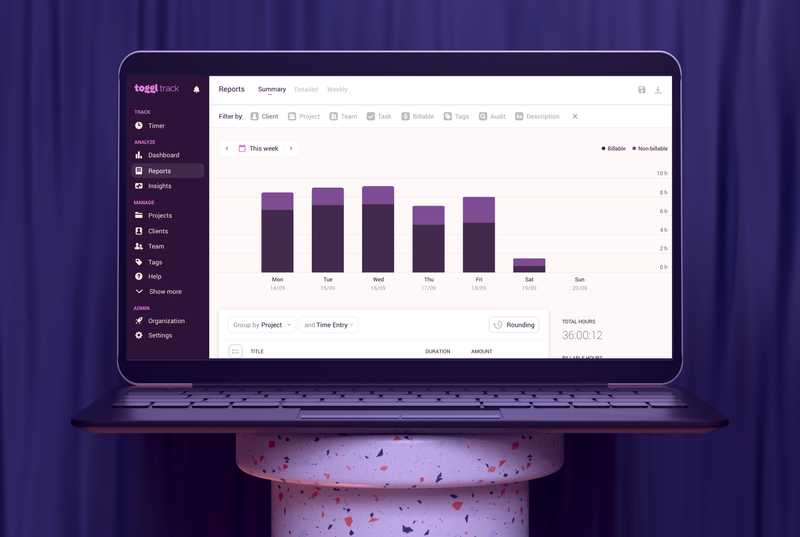
Supercharge your productivity
Toggl removes the most tedious and time-consuming parts of time tracking. It gives you insights into employee time, productivity, and project progress. Above all, it helps you streamline workflows and make better, more informed decisions.
Sign up for a free account with Toggl Track and discover a better way of working. Here are some of the features you’ll enjoy with a free account:
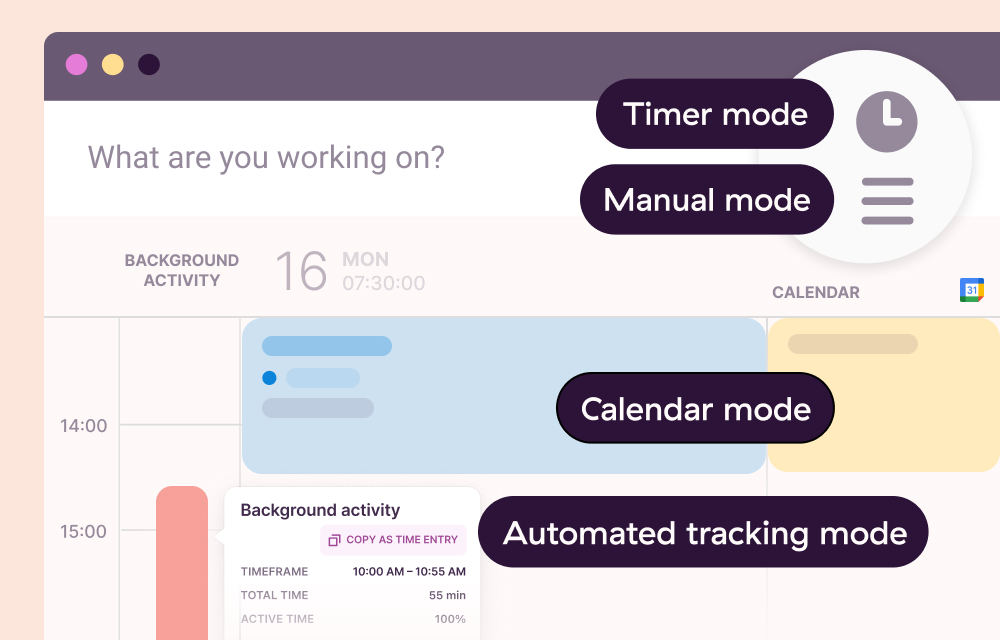
Automated and manual time tracking
Toggl Track ensures you never forget to track time with automatic time tracking, reminders, and notifications to start a time entry. You can also add entries after the fact using the Manual or Calendar modes.
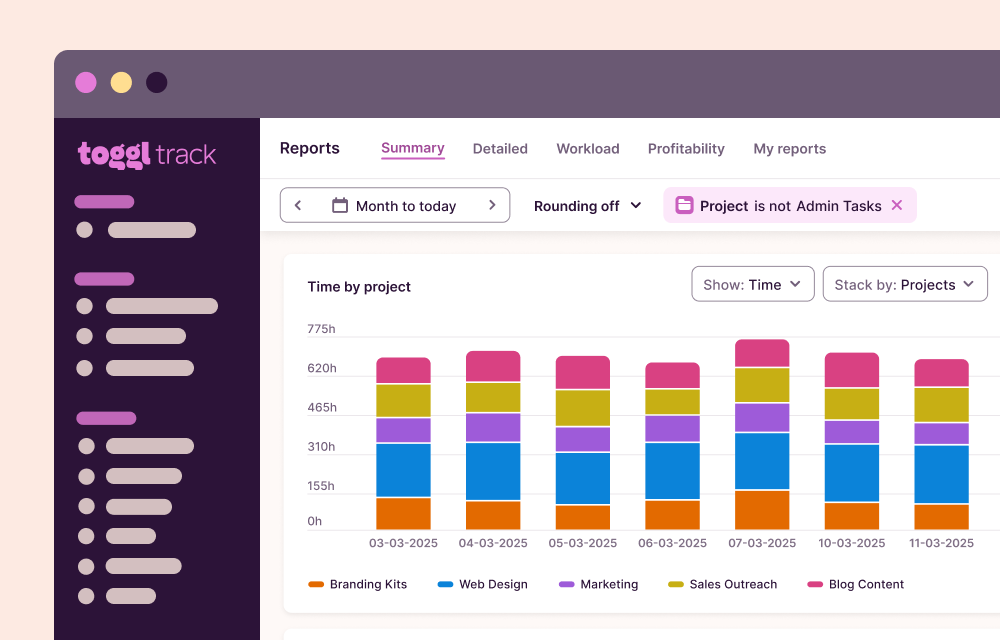
Data-driven time management

Seamless integrations
Our time tracking software offers 100+ interactions for calendars, communication & email apps, project management tools, and more. Track hours inside your favorite tools to remove constant tab switching and distractions.
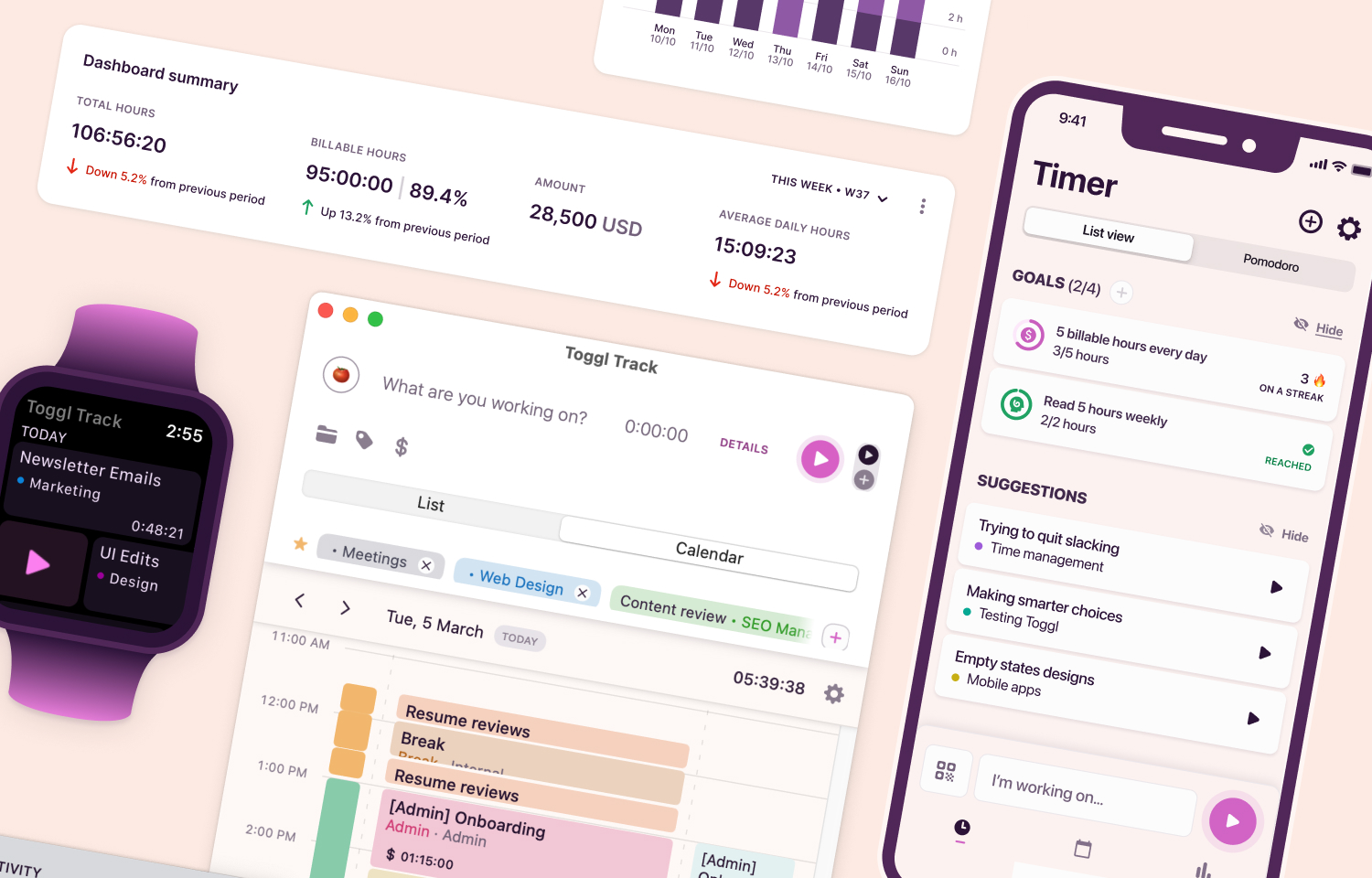
Web, mobile, and desktop apps
Toggl Track lets you track time your way, on your preferred devices. This includes a full-suite web app, desktop apps for Windows and Mac, and mobile apps for Android and iOS.
Sign up for free
Prefer a product demo instead?
Teams of 15+ are eligible for a personalized demo to see how Toggl Track can meet your time tracking goals

